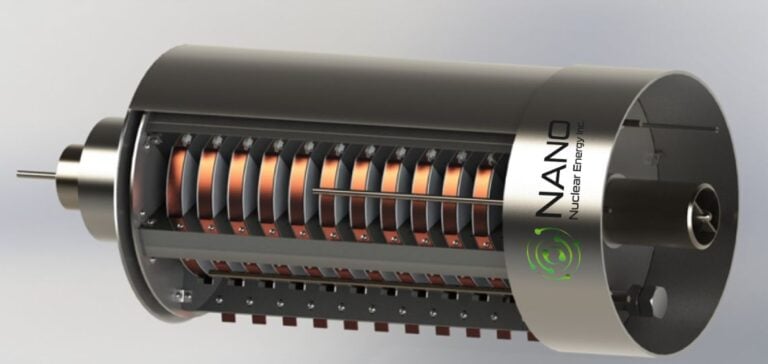NANO Nuclear Energy announces that it has filed a series of provisional patent applications with the United States Patent and Trademark Office (USPTO).
These patents are designed to protect the annular linear induction pump (ALIP) technology recently acquired and developed by Dr. Carlos O. Maidana.
This technology is crucial to the development of the ODIN micro-reactor, for which the company recently developed a nuclear fuel recycling solution.
Advantages of ALIP technology
The annular linear induction pump (ALIP) offers significant advantages over traditional mechanical pumps.
It operates without any moving parts, reducing noise and vibration while simplifying maintenance.
What’s more, this technology enables easy regulation of fluid flow, increasing operating efficiency.
ALIP technology is particularly well suited to reactors cooled by liquid metals and molten salts.
It promises to significantly improve thermal management in advanced nuclear reactors.
In June 2024, NANO Nuclear acquired this technology from Dr. Maidana.
Maidana, after the Department of Energy (DOE) awarded over $1.37 million in grants to support its development.
Application and Potential Impact
The patents are designed to secure the use of ALIP technology in nuclear reactors.
Jay Yu, founder of NANO Nuclear Energy, says the patents are essential to protect the company’s intellectual property.
He emphasizes that ALIP technology could revolutionize the nuclear industry by facilitating reactor modernization and optimization.
James Walker, CEO of NANO Nuclear, is optimistic about the impact of ALIP.
He points out that this technology is applicable to many existing and future reactors, thus contributing to carbon neutrality objectives.
What’s more, ALIP could find applications in the fusion industry for heat transfer and neutron capture.
Marketing prospects
ALIP technology, with its many advantages, is set to transform the energy landscape.
It would enable the construction of smaller, more efficient and less costly reactors.
NANO Nuclear Energy continues to develop this technology, aiming to integrate it into the ODIN micro-reactor and other advanced nuclear applications.
NANO Nuclear anticipates that, when commercialized, ALIP technology will be widely adopted in the nuclear reactor market.
This could include reactors using liquid metals and molten salts for cooling and heat transfer.
ALIP technology stands out for its ability to improve the energy efficiency and reliability of nuclear cooling systems.
Continuous Development and Innovation
NANO Nuclear Energy’s strategy is based on continuous development and technological innovation.
The acquisition and protection of ALIP technology is part of this approach.
The DOE’s financial support for this technology underlines its strategic importance for the nuclear industry.
ALIP technology is also in line with global efforts to reduce carbon emissions and promote clean energy.
By offering an advanced solution for thermal management in nuclear reactors, ALIP contributes to the transition to more sustainable energy sources.
By registering patents for ALIP technology, NANO Nuclear Energy is positioning itself as a key player in the development of advanced energy solutions.
ALIP technology, with its operational advantages and commercial potential, is set to play a crucial role in the modernization of the nuclear industry.






















